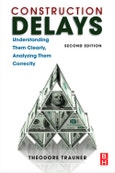Delays in construction projects are frequently expensive, since there is usually a construction loan involved which charges interest, management staff dedicated to the project whose costs are time dependent, and ongoing inflation in wage and material prices. Many techniques are used to analyze delays. Some of these methods have inherent weaknesses and should be avoided. This book points out the shortcomings of these faulty methods and explains how a delay analysis should be performed. It then describes specifically how the analysis is done with CPM schedules. A explanation of delays and delay damages, presented in a straightforward, accessible manner, should be useful to public and private owners, construction managers, general contractors, subcontractors, designers, suppliers, and attorneys whose work involves them in the construction industry. The discussion will include subtleties of the process, such as shifts in the critical path, and non-critical delays. The subject of damages is covered in detail, including the major categories of extended field overhead and unabsorbed home office overhead. Likewise, the damages suffered by the owner, either actual or liquidated, are also explained. Finally, a chapter is devoted to managing the risk of delays and time extensions from the viewpoints of the various parties to a construction project. A discussion of early completion schedules and constructive acceleration is also included.
In this new ediion, all chapters are updated to reflect the changes in the construction field since the first edition published over l6 years ago. The Second Edition includes over 40% more information such as new methods for analyzing delays with examples of the proper approach. The author also includes a new chapter on risk managment which focuses on the delay-related risks of the various parties in a construction project.
Please Note: This is an On Demand product, delivery may take up to 11 working days after payment has been received.
Table of Contents
ForewordAcknowledgements
Introduction to Second Edition
Chapter 1: Project Scheduling
The Project Schedule
The Purpose of a Project Schedule
Types of Project Schedules
What is the Contemporaneous Schedule?
What is the Critical Path?
What is Float?
Who Owns Float?
Reviewing and Approving the Project Schedule
Early Completion Schedules
Chapter 2: Types of Construction Delays
What is a delay?
Critical versus Non-Critical Delays
Excusable versus Non-Excusable Delays
Compensable versus Non-Compensable Delays
Concurrent Delays
Chapter 3: Measuring Delays'the Basics
The Importance of Perspective
Use the Contemporaneous Schedule to Measure Delay
Do Not Create Schedules After-the-Fact to Measure Delays
What to Do When there is No Schedule
What is the As-Planned Schedule?
What is As-Built Information?
The Importance of the Critical Path
The General Method for Analyzing a Schedule for Delays
The Unique Position of Subcontractors
Chapter 4: Delay Analysis Using Bar Chart Schedules
Bar Chart Schedules versus CPM Schedules
Defining the Critical Path
Quantifying Delays Using Bar Chart Schedules
Chapter 4 Example
Chapter 5: Delay Analysis Using CPM Schedules
The Advantages of Using CPM Schedules to Measure Delays
Identifying the As-Planned Schedule
Correcting versus Leaving Errors
Identifying Schedule Updates for the Purpose of Measuring Delays
Use of Scheduling Software and Other Software Tools in the Quantification of Delays
Chapter 5 Examples
Chapter 6: Delay Analysis When there is No Schedule
Use of Contemporaneous Documents for Sequence and Timing
Using an As-Built Analysis to Quantify Delays
Chapter 7: Other Analysis Techniques'Their Strengths and Weaknesses
Using Fragnets to Quantify Delays
Windows Techniques
Impacted As-Planned Analyses
Collapsed As-Built Analyses
Analyses Based on Dollars
But-For Schedules, Analyses, and Arguments
Chapter 8: An Owner's Damages Due to Delay
Liquidated Damages
Actual Damages
Chapter 9: A Contractor's Damages Due to Delay
General Guidelines for the Presentation and Recovery of Damages
Types of Delay Damages
Escalation of Labor Costs
Equipment Costs
Material Costs
Other Delay Costs
Chapter 10: Home Office Overhead
What is Home Office Overhead?
Effects of Delays on Home Office Costs
Eichleay Formula
Canadian Method
Calculation Using Actual Records
Net Present Value Analysis
Chapter 11: Inefficiency Caused by Delay
What is Inefficiency?
Ways That Delay Can Lead to Inefficiencies
Quantifying Inefficiency
Quantifying the Costs of Inefficiency
Chapter 12: Acceleration
What is Acceleration?
Why is a Project Accelerated?
Constructive Acceleration
How is a Project Accelerated?
Quantification of the Time Savings Associated with Acceleration
Quantifying the Costs of Acceleration
Chapter 13: Other Categories of Delay Damages
Damages Associated with Non-Critical Delays
Consulting and Legal Costs
Lost Profits/Opportunity Costs
Chapter 14: Determining Responsibility for Delay
Contract Requirements
Gathering the Facts
Evaluating Responsibility
Weather Delays
Chapter 15: Risk Management
Owner's Considerations
Construction Manager's Considerations
General Contractor's Considerations
Subcontractor's and Supplier's Considerations
Design Consultant's Considerations
Real Time Claims Management








